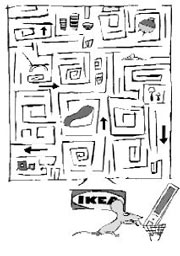EVERY NEWS DEPARTMENT gets besieged with press releases, promotional packets, and other, sometimes extraordinary gimmicks, all sent with only one goal in mind: to get us to mention them. In the case of big companies, this is much more explicit: They want us to give them free publicity in the form of a puff piece. They know the value of advertising; they just don’t want to pay for it.
As such, a lot of stuff shows up. Most of it simply gets tossed; but every once in a while, a corporate press release comes along with a headline so terrifying, so mind-numbingly awful that, as a public service, it must be written about. You must be warned: Ikea is doubling in size.
Specifically, we learn, later this month Ikea’s Southcenter-area store opens a new section, its fourth in seven years, thus doubling its original size. Ikea proudly figures this news will inspire all of us to rush right out and buy twice as many modular whatevers at reasonable prices. Don’t. Don’t do it. If you’ve never been to that store, take my word for it: You, or someone you love, may never come back.
It’s not just that the store represents massive retail overkill, the type of now-fashionable “big box” store that shows up on photos from space looking sort of like an extra ice cap. It’s not just that entire Third World countries lack firewood because of particular Ikea outlets.
Their stores are arranged with one-way only aisles, so that you are prompted—commanded, really—to pass through every section of the store, past thousands of TV screens and screaming kids and point-of-purchase displays, to pay for your new particleboard bookcase. If you’ve never seen how an Ikea store is laid out, remember that game you had as a kid where you tilt a board on two planes to try to get a marble or steel ball past a bunch of numbered holes in a maze?
Ikea is laid out exactly like that. Last fall they ran the first annual Renton Marathon inside Ikea’s Southcenter store, because two laps of the store, following the ubiquitous red one-way arrows on the floor, happens to be exactly 26.2 miles.
The sinister thing about all this is that, just like that childhood game of old, the Ikea stores also have holes. Actually, they don’t, literally, anymore; animal rights activists objected to the tigers in the old Ikea tiger pits, even though the big cats ate well. Instead, now Ikea stores have little side entryways and occasional innocuously misapplied arrows pointing the wrong way. People go wandering down those aisles and never come back. Your child, mother, or best friend could be next! The word “Ikea” is itself Swedish, from “ich” (“child”) and “eeaaahh?” (“Where’s my . . . ?”).
Nobody’s sure what becomes of the disappeared. We sent out three reporters to try to gauge in what direction Ikea will be expanding its store—with a gargantuan parking lot on all sides, it’s not obvious. It could involve extra dimensions or alternate universes. And our reporters might be in them, because they all failed to return. The spouse of one got a postcard; judging from the stamp, he thinks it’s from Cambodia. The smudged writing seems to say something about a sweatshop, slavery, and credenzas. But he’s not sure.
I cannot imagine why Western Washington needs an even larger Ikea store. Ikea, of course, think it’s all quite wonderful; they’re even luring media with promises of an appearance by some Swedish Ronald McDonald-type pitchman. That’s what my mute button is for.) But even in Ikea’s own press release, there are hints of the darker truths involved. Especially where it describes an area in which ” . . . children can now be conveniently picked up near the Restaurant for family lunch or more shopping.”
Are we shopping with the children? Or buying them? Or eating them? (For “family lunch”?) Is “Restaurant” some cult reference? And WHOSE CHILDREN? Day of the Dead, anyone? Stephen King in the Mall of America?
Ikea is quintessentially global—it’s unlikely a single sale item in its 3,714,091,632,021,226-item store was made entirely in the U.S., and Ikea markets itself as militantly Scandinavian.
The eerie visage of hundreds, no, thousands of happy and acquisitive Americans, at any given moment, herded down those one-way mazes, from which everyone—well, almost everyone—emerges with identical bargains like lab mice finding their cheese, is hard to shake. Is this “globalization”?
And all those happy shoppers never seem to see the people snatched from their midst or the ghosts living among the dinette sets and sofas. Oh, the humanity.
You’ve been warned.







